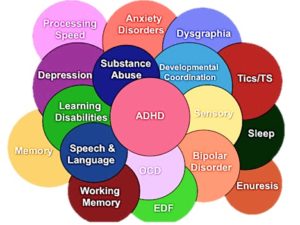From 2002 to 2007, the diagnosis of adult ADHD has increased more than three-fold. After the diagnosis of their child, adults realize they too could have ADHD. Adults seeking a diagnosis should know that there are differences in diagnosing ADHD in adults and children.

Adults with hyperactive symptoms often have trouble relaxing.
In order to diagnose ADHD, individuals must experience symptoms listed in the Diagnostic and Statistical Manual of Mental Disorders (DSM–5). These symptoms occur in categories of inattention and/or hyperactivity-impulsivity. The issue with the DSM-5 symptoms is that they are geared more towards children. For example, “talking excessively” is a symptom under hyperactivity. While children talk excessively in class, most adults know that is unacceptable behavior in social situations and constrain themselves. Instead of talking excessively, a hyperactive adult has trouble relaxing and remains tense. Because adults have different manifestations of symptoms than do children, adults only need to present five symptoms in one of the categories to be diagnosed with ADHD while children need to present six.

Doctors interview adults when diagnosing ADHD.
Diagnosing ADHD requires establishing that symptoms are present in two settings and that these symptoms cause impairment. For children, those two settings are often home and school. In order to meet this criteria, teachers and parents submit behavioral checklists and additional ADHD rating scales. These assessments do not work well on adults because they present symptoms differently than do children. Instead, physicians use in-depth interviews to ask specific, pre-determined questions to the adult. The questions help relate the symptoms listed in DSM-5 to symptoms adults experience. One question may address current issues like asking what tasks have been difficult to complete in the past week.
While diagnosing ADHD in adults, physicians must take additional measures to meet criteria of DSM-5, which requires proof that symptoms of ADHD were present prior to age 12. For children coming in who are not yet 12, this poses no issue. For adults, however, physicians must ask questions in the interview if symptoms the adult experiences currently were experienced as a child.
While parents and teachers help diagnose ADHD in children, adults may not have the same access to other opinions. Doctors may interview spouses to determine if symptoms have affected relationships, but if a spouse is not available, physicians must rely on self-reports from the interview to determine if symptoms have caused impairment in two settings.

Other conditions often occur with ADHD.
Before completing the diagnosis of ADHD, physicians must test for co-existing conditions to determine if conditions besides ADHD are causing the individual’s symptoms. As doctors test adults and children for conditions like anxiety, adults require additional medical tests for conditions like thyroid problems that can mimic symptoms of ADHD.
While adults must go through additional medical testing and greater in-depth interviews, it seems as if their diagnosis is trickier than that of children. Children do have greater sources of information from teachers and parents while adult diagnosis relies more heavily on self-reports. Adults also must prove symptoms occurred before age 12. These challenges, though, have not hindered the increase in adult ADHD diagnosis.
Sources:
http://www.chadd.org/Understanding-ADHD/For-Adults/Diagnosis-of-ADHD.aspx
https://www.ncbi.nlm.nih.gov/pmc/articles/PMC2559915/
https://www.nimh.nih.gov/health/publications/could-i-have-adhd/index.shtml#pub2
You did a great job of exploring a topic that is not often mentioned when we talk about diagnosis and treatment of ADHD. I found it helpful that you compared the diagnostic processes in adults and children, and noticed how much more complex this process is for adult patients. It must be so much more challenging for an adult experiencing ADHD symptoms to pinpoint the true problem, as they must interact with such a variety of people and situations in their daily lives (compared to children, who experience school and home for the most part). In addition, you did a great job of making your post clear and clean, with a good layout and interesting pictures and hyperlinks.